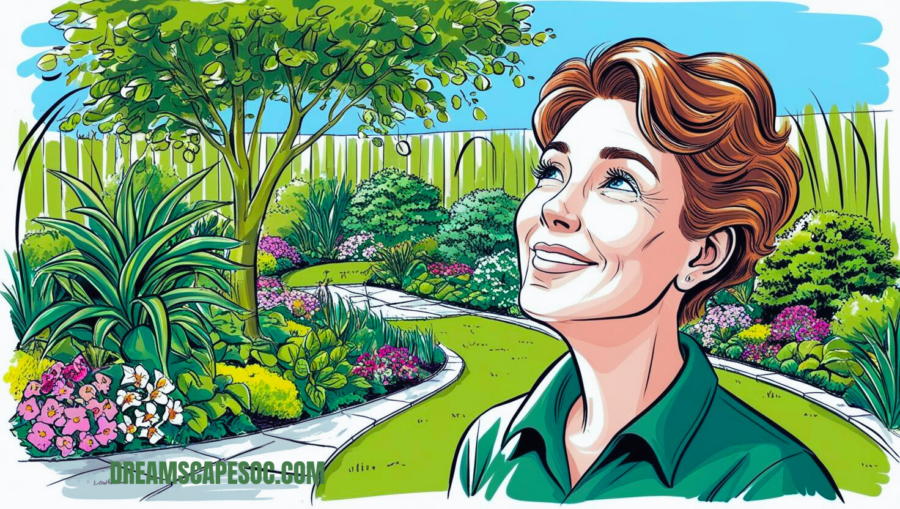Understanding Seasonal Flower Planting
- Seasonal Flower Planting: Seasonal flower planting is all about working with nature to keep your garden blooming beautifully all year. This means choosing plants that naturally grow best during each season. When you plant with the seasons in mind, you’ll not only create a garden that looks great year-round but also save yourself a lot of time and effort. Seasonal flowers are easier to care for, more resilient, and attract pollinators like bees and butterflies.
- Benefits of Seasonal Flower Planting: There are many perks to this approach. First, you get a constant show of colors and textures as each season changes. Seasonal planting also keeps maintenance simple, with flowers that need less fussing over and fewer pesticides. Plus, you’re contributing to local biodiversity by encouraging pollinators and giving a home to other helpful insects.
Elevate Your Outdoor Space—Explore Exclusive Landscaping Concepts
Seasonal Breakdown of Flower Planting
- Spring Planting: Spring is when the gardening year really kicks off. As the weather warms and days get longer, it’s the perfect time for planting early bloomers who love a bit of sun but don’t mind cooler nights. Think vibrant colors and fresh, bright greens.
○ Popular Spring Flowers: Some top spring flower choices are tulips, daffodils, and hyacinths. Tulips bring a rainbow of colors, from classic reds to exotic purples. Daffodils are sunny, hardy flowers that come back every year with minimal effort, and hyacinths add fragrance that fills the air with a sweet, fresh scent.
○ Spring Planting Tips: To get your spring flowers off to a good start, prepare your soil in the fall. Loose, well-drained soil helps bulbs settle in for a strong bloom season. Space bulbs are about six inches apart, so their roots don’t have to compete.
- Summer Planting: When summer hits, the garden comes alive with bold, sun-loving flowers. This is the time for big, showy blooms that can handle hot days and plenty of direct sunlight.
○ Ideal Summer Flowers: Sunflowers, zinnias, and marigolds are summer stars. Sunflowers add a cheerful touch with their towering height and large, sunny faces. Zinnias are heat-resistant and colorful and bring a beautiful texture to summer gardens, while marigolds offer vibrant orange and yellow tones and can even help keep pests away.
Tips for Summer Planting Summer flowers are thirsty, especially during dry spells, so watering early in the morning allows the water to seep in before the sun becomes too hot. However, you should water as frequently as you can. Make sure these flowers get at least six hours of direct sunlight each day. Adding some mulch around them will help retain moisture and keep weeds away.
- Autumn Planting: As summer fades, autumn brings its own magic to the garden. Fall is the season to plant for late blooms and to get spring perennials in the ground.
○ Best Autumn Flowers: Chrysanthemums, asters, and goldenrods are excellent for a touch of autumn beauty. Chrysanthemums are hardy and come in warm shades like red, yellow, and orange. Asters have a classic daisy look and add a rich purple or blue hue, and goldenrods bring a bright yellow that stands out in the cooler months.
○ Tips for Fall Planting The fall is the best time of year to plant perennials since they may establish roots before winter. These plants benefit from mulching the soil when the temperature begins to drop. Reduce watering as the temperature drops since the plants will naturally need less water as they slow down.
- Winter Planting: Winter doesn’t have to mean a barren garden. While most plants go dormant, there are hardy winter flowers that thrive in the cold and add life to your garden even during the frostiest months.
○ Hardy Winter Flowers: Pansies, hellebores, and snowdrops are some favorites. Pansies come in cheerful colors that handle light frost well. Hellebores, also called “Christmas roses,” are winter classics with blooms that add charm during the chilly season, and snowdrops are delicate white flowers that often bloom before winter ends, signaling spring is just around the corner.
○ Winter Planting Tips: For winter gardening, use frost covers on especially cold nights to protect young plants. Adding compost or a slow-release fertilizer in winter can also keep the soil enriched. Space winter flowers generously to give them full access to the limited sunlight.
| Season | Soil Prep Tips |
| Spring | Add organic compost to boost nutrients for fresh growth. Loosen soil to help roots breathe. |
| Summer | Apply mulch to prevent weed growth and maintain soil moisture. Compost can be added to soil to keep it nourished. |
| Autumn | Mix in aged manure or compost to improve soil structure. Get soil ready for winter root growth. |
| There’s no need to prepare for winter | Especially for perennials, cover with a light layer of mulch or compost to act as insulation. |
Key Takeaway: Seasonal flower planting is your key to a garden that’s always blooming. By picking flowers that suit each season, you can create a vibrant space that’s easy to maintain, promotes biodiversity, and supports local wildlife.
Transform Your Outdoor Space Today – Download Your Free Landscaping and Gardening Checklist
Choosing the Right Flowers for Your Region
- Climate Considerations: Choosing flowers that suit your local climate is essential. Whether you live in a temperate, tropical, or desert climate, selecting flowers that naturally thrive in your region makes a world of difference. In temperate areas, many traditional flowers like roses and daisies will do well across multiple seasons. Tropical climates can handle more heat-tolerant flowers like hibiscus and bougainvillea, while arid zones benefit from drought-tolerant blooms like lavender and echinacea.
- Native vs. Exotic Flowers: Going for native plants is usually the easiest option. Native flowers are adapted to local conditions, so they require less care and are better for the local ecosystem. They attract native pollinators and usually have built-in defenses against local pests. Exotic flowers can add a unique look to your garden but may require extra care to keep them healthy.

Tips for Seasonal Planting Success
- Fertilization and Soil Preparation: Healthy soil is the foundation of any successful garden. In the spring and summer, add organic compost to your soil to raise its nutrient content. This encourages strong, colorful flower growth. As fall and winter draws near, apply well-aged manure to improve soil structure and prepare for the colder months.
- Water and Maintenance: It’s critical to adjust your watering schedule according to the season. Deep root hydration is typically the goal of water in the spring and summer to withstand heat. In the fall, when the weather cools, water is less, and by winter, water is only necessary to avoid root rot.
- Control of Diseases and Pests: Employ natural methods to safeguard your plants whenever possible. Effective pest-repelling techniques include neem oil, garlic spray, and diatomaceous earth. Steer clear of growing the same flowers in the same location year after year to help break disease cycles and avoid soil-borne illnesses.
Sustainable Practices in Seasonal Flower Planting
- Eco-Friendly Gardening: Eco-friendly gardening supports your plants while being kind to the environment. Composting is a great way to turn your kitchen scraps and yard waste into natural fertilizer that boosts soil health. Avoid synthetic pesticides and opt for organic or homemade alternatives to keep your garden as green as possible.
- Attracting Pollinators: Pollinators like bees and butterflies are essential for a healthy garden. Plant flowers with staggered blooming times so there’s always something in bloom to keep them around. Your flowers will draw a greater range of pollinators if you vary their sizes, shapes, and colors.
Dive into related articles now for even sharper insights—you won’t regret it!
Conclusion
A seasonal approach to flower planting is your ticket to a colorful, thriving garden all year round. From winter’s hardy blooms to summer’s bold flowers, each season offers unique opportunities to enrich your garden.
FAQs
How do I choose flowers for my region’s specific climate?
Start by researching which flowers naturally thrive in your area’s climate. Native plants are usually a safe choice because they adapt to the local environment and need less care.
Can I have flowers that bloom across multiple seasons?
Many perennials, like daisies and coreopsis, can bloom from late spring through early fall, offering continuous color. Look for long-blooming varieties if you want flowers that last.
What’s the best way to keep my plants safe from frost?
Use frost covers on freezing nights and mulch around the roots to provide insulation. For winter flowers, choose frost-tolerant varieties that naturally handle more frigid temperatures.
What are some natural ways to keep pests away?
Try using neem oil and garlic spray, or even introduce beneficial insects like ladybugs. Companion planting, where certain plants naturally repel pests, is also effective.
How do I keep my soil healthy through all the seasons?
Use natural fertilizers, rotate your plants each season, and replenish your soil with compost or other organic materials on a regular basis. This keeps your soil nutrient-rich and promotes healthy plant growth throughout the year.

